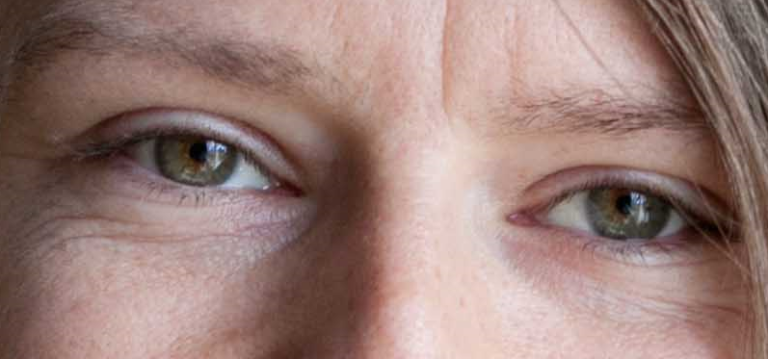Sure, we all lose our cool at times, but don’t you just hate looking back on a situation and wondering: “WHAT HAPPENED?! I wasn’t gonna DO that anymore! I did that #$%* THING AGAIN!! I’m hopeless!”
Maybe you said the thing that you know sets your partner off. Part of you flew off the handle in a rage. Part of you froze into place petrifiedly watching it all unfold like a deer in the headlights.
Well, whether or not you left in a huff, I promise you: you have solid reasons to want to. Rational reasons that need recognition before things will start going differently.
I swear: you make perfect sense.

Keeping Your Cool Isn’t Just About “Finding the Gap”
In therapy, Buddhism, and lots of other places they’ll tell you to “find the gap”—find that magical moment of possiblity and choice between the prompt …and your reaction. The irritation, the thing that gets your goat, the “trigger” …and your involuntary response.
The problem with that approach is: you’ve been trying to not have your usual reaction anymore. AT ALL. So that moment is not the time to try and “find” the #$%*ing gap”—AND somehow magically “make a better choice.”
If that worked, your response would’ve changed already.
You would never lose your cool again.
End of story.
Instead, You’re Here
Since “finding the gap” and then just hoping for the best hasn’t worked for you, your situation has probably been underestimated. What’s probably happening is: people haven’t liked your usual automatic response to this type of situation/”trigger” for a long time. Maybe even for as long as you can remember. Not only does that put you in an empathy-deprived state of mind, but moreover:
Over the years, that gap has gotten smaller and smaller …and smaller.
It’s auto-pilot. It’s a script. A protocol. Pre-determined reality. A pattern people expect and play into, even. A relationship dynamic.
It’s not gonna change just from pressing pause, taking a deep breath, and hoping for the best all of a sudden.
Optimism can be scary foolish, because you know…
It Could Be Worse
You actually have good reason to lose your cool.
Say it with me: There’s good reason TO KEEP DOING that thing people insist you should stop doing.
At some level, your “bad” behavior is meant to actually prevent something even worse from happening.
Let’s say you went at some stranger’s door with an axe and broke in in broad daylight, yelling and knocking over stuff as you barged in on them and dragged them out of there kicking and screaming about their dog or whatnot.
But you’re a fire-fighter and if you didn’t, they’d asphyxiate and burn alive in that building.
IN YOUR CASE: nobody else knows there’s a fire to put out. Not even you, at some level. But there is. And it’s as real as your breath.
It’s Like an Emergency
In an emergency that’s on repeat (whether in your brain alone, or in shared reality) you get to know the drill. You follow the protocol for dear life as a way to KEEP your cool. You do the right thing, without expecting any thanks.
But that fire, that danger, that real-but-invisible emergency would need recognition and relief if your response to things that look, sound, and feel similar is ever gonna change.
No number of deep breaths “counting to 10” will dampen the flames. Nobody else’s imaginary white light is gonna make it go away. No punishments, no threats, no amount of pressure to change your behavior will have any wise effect when that gap comes. (And goes.) There’s more to it than that.
“Wishing for the best” hasn’t worked. And inserting a different behavior hasn’t stuck. Because it doesn’t address the emergency. Not in a smart, present-moment, intelligent way.
Don’t kid yourself. You’re a fire-fighter suddenly, and anything goes.
Period.
If Not “in the Moment,” When?
If you really believe finding that “gap” is going to ever help you behave any differently in that situation, you’re probably reluctant to try the only other approach. It’s a potentially very painful, embarrassing thing. You’d have to spend time thinking about that horrible moment – a moment you can’t really remember well. And you’d have to do it when you feel fine.
Revisit the lack of “gap” with hindsight? No thanks. No stewing in the bad chemistry of those confusing moments when you lose control. No replaying the glitch in the Matrix to analyze the moment fate changed. It’s not date night conversation. You aren’t even sure what happens.
Who wants to spend their free time thinking about THAT at a time when you’re not even having the problem?
Nobody.
Because it’s embarrassing if you’re doing it by yourself. Or with someone who’s embarrassed for/with/at you. Or with someone who’s like: “please stop your inappropriate behavior.” Or with people you’ve pushed away. Or with nobody, because you’ve pushed everybody away.
If Not with Your Lover, with Whom?
Maybe you need a space where you CAN reflect on that stuff, find that “gap,” and l e n g t h e n it so that you regain access to your prefrontal cortex next time. Access to smart, resourceful choicefulness instead of shut-down. It’s an option. It really helps.
You’d need time and space with someone who’s not implicated. Who’s seen worse and “gets” you and isn’t at all worried because they’ve helped many people exit the viscious cycle you’re still in. Time with someone who won’t pull out a bible, a divining rod, or the Diagnostic and Statistical Manual of Mental Disorders.
Someone logical and technically-minded, like you.
I Help Guys Keep Their Cool.
There are many ways to tap the gap and change the name of the game. Different practitioners I can recommend. Work that takes effect at variable speeds. Me, I work specifically with men who want results yesterday (but will settle for guaranteed* results within 2 days.)
Yep: on Day 1, we document “the gap.”
For the first time ever, it no longer escapes or overwhelms you. It’s not all better, but it’s much, much better than before.
Life is better from Day 1: shame stops driving you (or at least gets in the back seat while it tries to continue to do so) and Day 2 is on your calendar, so the end is in sight!
On Day 2, our task is to get more of your brain ‘back online’ and accessible even when you’re embarrassed or checked-out. Imagine having the capacity to come up with words, choices, and actions that you could normally only think up in hindsight!
Best of all: right away, from Day 1, the situation that used to drive you to despair becomes not only less frustrating, but actually, it becomes interesting instead of aggravating.
Why?
Get this –
because even other people can tell that a subtle-but-big change is afoot. So people pay attention to you slightly differently.
*Guaranteed? Yep. Because Hope Can Be a Dangerous Thing
Hope can be frightening. It can bring up all the hidden desires you never allowed yourself to have. It can be physically painful, to the point of making you wonder whether being sucked into a vaccum or over the edge of infinity into a black hole might be simpler, more predictable, and the only guarantee to end the pain.
I know, because that’s where all of my clients are when they come to me. This is not a pressure tactic or a sales spiel. I’m just saying what most of my clients would need to hear if they had read this far. Hope is painful. Not deadly, but not sustainable indefinitely, either. If that’s you, maybe consider my offer.
For those who prefer to subscribe for year(s) first and get to know me better before bearing their hearts to me (been there! done that!) my next post will be about how to evade difficult conversations. I’ll give you a tool to do it with, too.
Because life is messy.
And preparation can be a great comfort.

